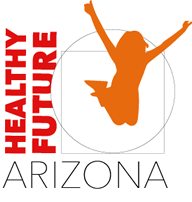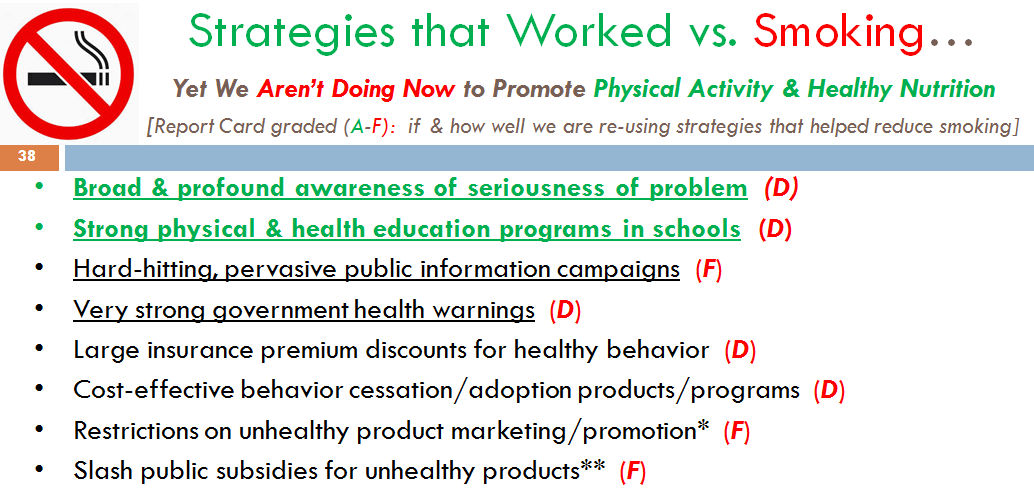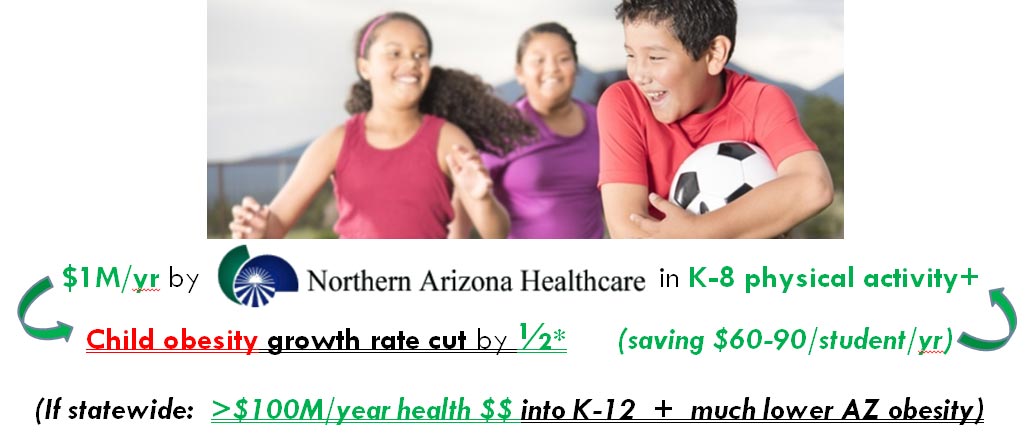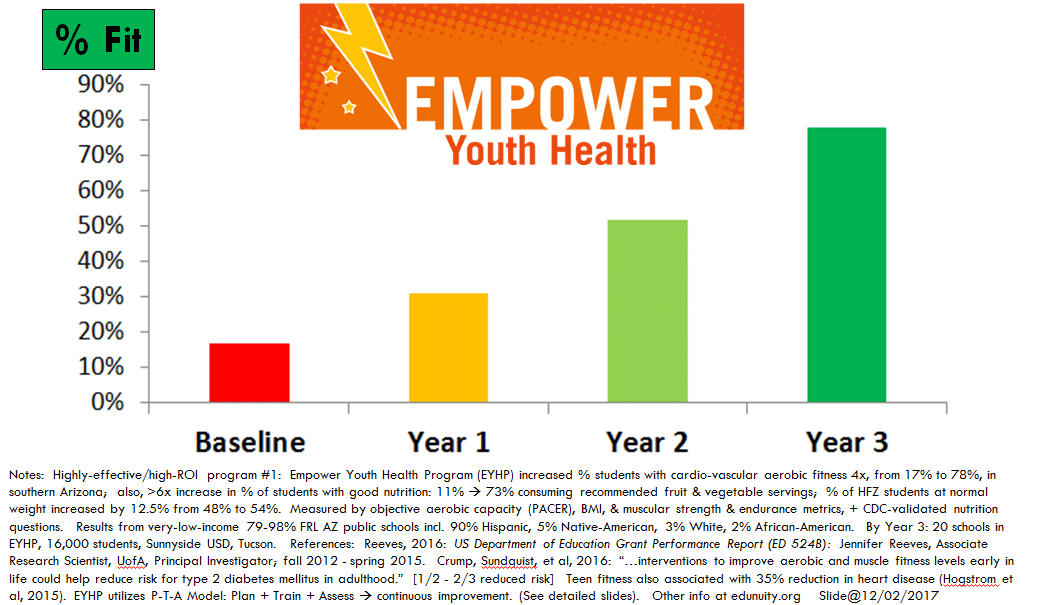Healthy Future Arizona Plan

The Healthy Future Arizona vision is for Arizona to become the healthiest state in the country. We will get there with a statewide coalition, committed to empowering individuals to substantially improve their health—particularly with school-based approaches.
Our coalition plans to scale up our proven evidence-based approaches and implement them statewide—beginning in lower-income schools with the greatest needs. As part of our core mission and values, these approaches are and will continue to be accountable, highly-effective, affordable, scalable, systemic, long-term, and sustainable—with a high demonstrated ROI.
We define “health” in a whole-child, whole-person context, starting with physical health, but also including social-emotional and mental health—and eventually financial, civic, creative, and other types of “health”. Generally speaking, none of these are being adequately developed and assessed at present in K-12 schools.
Healthy Future Arizona’s initial focus is on dramatically improving K-12 physical and health education, as an essential foundation for lifelong health. While we start in K-12 schools, we look at health in its broader social, political and economic context and over the entire lifespan. And we realize that healthy habits begun early in life, as children, must then be reinforced by other public policies and private practices, as adults—so that the healthy behavior begun in schools does not fade out and revert to unhealthy social norms in the future.
The highly successful, multi-decade fight to reduce smoking through a broad range of strong public policies has been inspiring. The antismoking movement has demonstrated the potential to reverse very unhealthy habits among 25% of all adults–even though those habits were anchored in the physical addiction of nicotine. Smoking was reduced from 42% of adults in the 1960s to 17% today—and still decreasing!
But as with tobacco usage, in order to introduce effective policies to improve the public’s physical activity and nutrition, we need a broad coalition of our leaders to intentionally set out to do so. And success in schools is essential. The Healthy Future Arizona plan is dedicated to making this happen.
We have a rapidly-growing coalition of education and health leaders, as well as political, business, nonprofit, foundation and other leaders, to achieve this. Our core approach is to develop long-term, affordable, sustainable, evidence-based, “win-win” partnerships between schools and health organizations. In addition to a number of individual school and political leaders, some of our coalition education, nonprofit, community and health organization partners include:







In the HFAZ model, the health sector invests on a pay-for-performance basis, through a shared-governance intermediary, in more effective quality physical and nutrition education. This results in healthier children and families, rapid payback of investment, and high long-term ROI for health organizations and budgets. K-12 schools gain, by not only developing healthier students, but also improving academic achievement and student engagement—as increasing moderate-to-vigorous physical activity enhances cognition.
Schools receive new money into schools now, while also protecting their existing funding into the future. Otherwise, state budgets will be overwhelmed by the 1/3 of students in the classroom today, who are projected to have diabetes as adults.
Increasing school recess is key to having enough time for physical activity, as well as generating other social-emotional benefits. Recess also increases student engagement and motivation for school, with many students looking forward to recess as a welcome & needed break from classroom instruction. New research evidence even shows that recess & outdoor time improve eyesight—as many children avoid near-sightedness by having to adjust to rapid changes in distances playing outdoors.
As the evidence of better health outcomes continues to grow, Healthy Future Arizona will use monitoring & evaluation data from our programs and practices to secure matching appropriations and AHCCCS/Medicaid investments, based on proven payback and ROI benefitting all.
Win-Win: From Medication to Education
It is said that all state budgets consist primarily of “education, medication and incarceration”. There is a long-term trend toward states spending more on “medication” and less on “education”, as health costs go up—and the population becomes lower-income and unhealthier.
How do we prevent the on-going shift—away from funding education for a better future, toward publicly subsidizing chronic conditions caused by many years of unhealthy habits? What can we do, as fully 5% of the Arizona state budget has shifted from education to health over the last 15 years—and as this trend worsens with our shifting demographics?
How will we have enough money available in the future to adequately fund education, when we are already struggling to meet basic K-12 spending needs—and as the mounting costs of obesity, diabetes, heart disease, preventable cancer, etc., overwhelm government and family budgets?
Fortunately, the evidence shows that we can kill two birds with one stone: we can help increase funding for schools, and reduce health spending—by helping to re-focus the state on quality, effective physical and health education and physical activity at school. We have two major, nationally significant, K-12 breakthroughs in our state, which provide clear evidence for this:
Empower Youth Health Program
The Empower Youth Health Program (EYHP) began in 2012, and by 2015 was improving physical and nutrition education among 16,000 students in 20 schools in Pima County. As a result, while 83% of students were unfit in 2012, only 22% of students were still unfit in 2015–a remarkable 4x improvement in cardiovascular fitness—which has drawn the attention of the CDC and the Presidential Youth Fitness Program nationally.
These outcomes were measured objectively by the nationally validated assessment, FitnessGram®, successor to the Presidential Physical Fitness Test. FitnessGram or similar criterion-referenced fitness evaluations are used for statewide testing in as many as 20 states.
Yet the Empower Youth Health Program costs only $10/student/year at statewide scale.
EYHP achieves these results at such low cost by working with existing school staff, rather than adding more staff. The Empower Youth Health Program helps schools to Plan + Train + Assess (P-T-A), in order to develop healthier students:
- create and implement an effective school wellness policy plan, including utilizing the CDC’s School Health Index (SHI) to prioritize;
- professionally develop the school’s certified PE, health ed & classroom teachers to increase moderate-to-vigorous physical activity (MVPA) in PE classes, recess, classrooms, and before-and-after-school,
- including peer-led student activities;
- continuously improve physical and health education-related processes and outcomes,
- guided in part by regular fitness, physical activity, nutrition & other assessments;
- and engage parents and the community in achieving better health through parental components, School Health Advisory Councils (SHAC), and other means of addressing the social determinants of health.
Fit Kids
The FitKids of Northern Arizona program in public elementary and middle schools in the greater Flagstaff area cut the rate of growth of child obesity in half, in just two years. Northern Arizona Healthcare, the dominant hospital and health care provider in the Flagstaff area, has funded instructional support through Fit Kids to increase physical activity among almost 10,000 students per year since 2012, at a rate of close to $1 million annually.
If every other major hospital group in the state did the same, that would provide approximately $100M/year to schools to improve physical education and physical activity.
Win-Win: Education + Health Sectors
Why do health care organizations invest in schools? Because clinical settings alone have not been improving health behavior adequately—and without healthier behavior, the chronic conditions epidemic will grow—and continue to harm children, families, employers, and government budgets.
In fact, K-12 is the only practical, affordable setting to instill healthy habits in our population as a whole. (Of course, healthy habits must be reinforced in the workplace and at home, to prolong habits learned at school into adulthood.)
Once health insurance plans step in to help reimburse these costs, and the legislature and AHCCCS/Medicaid co-invest, we can reach $300-500 million per year in new money into schools—while reducing & preventing diabetes, obesity, high blood pressure, many cancers, & other chronic health conditions. (Yes, even many cancers are associated with the lack of physical activity and unhealthy nutrition; obesity is the second largest preventable contributor to cancer, following smoking.)
Edunuity has estimated that we can reduce preventable chronic conditions and associated costs among the non-elderly adult population by 20%, through the Empower Youth Health Program and other K-12 approaches—and up to 50% among the entire adult population—by reinforcing the Empower Youth Health Program with other policies for ages 0-5 and among adults.
(For comparison: we are approaching a 2/3 reduction in smoking nationally, following decades of serious school-based and other policies!)
Payback & ROI for Health Organizations
The Healthy Future Arizona coalition is making significant progress toward increased health sector funding of quality, effective physical and health education, recess, and physical activity at school. We now have evidence, showing that this investment in moderate-to-vigorous physical activity saves the health sector at least $30-50/child/year in reduced child health costs during the first year—and thousands of dollars per year in long-term savings for the rest of the child’s adult life.
This pays back the costs of the Empower Youth Health Program in the first year.
In addition, the Fit Kids program, which adds staff to K-8 schools to increase physical activity & nutrition education, is estimated by Edunuity to save $60-90/child/year, due to reduced child obesity & other health conditions—paying back in the first year its somewhat higher costs, which result from adding on-site health aides to increase physical activity.
Since these programs “pay for themselves” immediately, the long-term cost savings with both programs fall “straight to the bottom line”.
A-F School Accountability & Related Policies
As part of our strategy, we are developing state support for effective, quality physical and health education. The A-F accountability formula and “school report card” are an essential part of this.
Working with AzHPE (Arizona Health & Physical Education professional educators’ association) and others, we are proposing a practical, low cost, school-friendly, valid & reliable approach to add physical and health education indicators to the state’s A-F accountability formula. Our proposal provides an evidence-based, intended, “good incentive”—for the majority of schools, which have cut PE to 2 days/week or less. They will be much more likely to invest more time in moderate-to-vigorous physical activity and developing lifelong healthy habits among all students.
Schools do not need to spend more to do this—just reallocate time which was taken away over the past 20-30 years back to PE, health ed, recess and the arts. A mountain of evidence shows that slashing “specials” and recess did not improve student achievement in reading, writing, and math—but it harmed children’s health, social-emotional development, and creativity.
Schools can improve student health, academic achievement and student engagement, synergistically, as the evidence shows.
Schools which implement the Empower Youth Health Program should be able to maximize their physical & health education-related points, to help improve their school’s A-F grade.
We look forward to the state’s re-engagement in physical and health education (and arts education), as an essential foundation for a healthy future for our children, our schools, our health system, and our state.
(Please see our latest slide deck for more details, as well as this list of research evidence references.)







